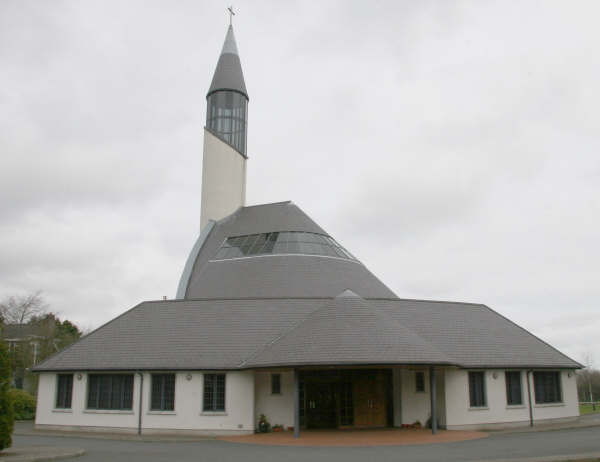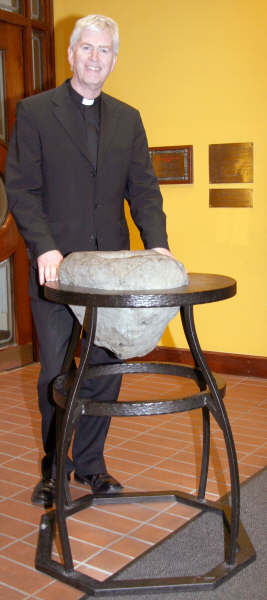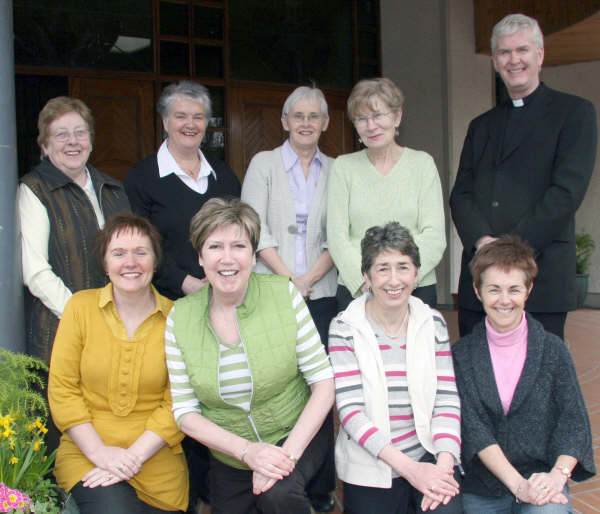
Church of Our Lady Queen of Peace
 |
_small.jpg) |
| Church of Our Lady, Queen of Peace, Dunmurry. The church was opened in October 1999. | The beautiful Church of Our Lady, Queen of Peace, Dunmurry. |
 |
 |
| The Very Rev Colm McBride pictured at the original Holy Water Font | The Very Rev Colm McBride Parish Priest |
130 Dunmurry Lane, Kilwee, Dunmurry
Parish Priest: The Very Rev. The Very Rev Colm McBride PP
Telephone: 9061 6300
Sunday Eucharist: 6.30pm.
Vigil, 10.00am. and 12.00.noon
Website: www.downandconnor.org
 |
| Fr McBride pictured with the flower group and some ladies of the parish who clean this beautiful modern church located on the outskirts of Lisburn. |
HISTORY
The Parish of Kilwee, the name of which recalls a thirteenth century monastic foundation, was formed in 1996 mainly from St. Anne’s Parish but also with territory from Hannahstown Parish. Canon Patsy McGarry was appointed parish priest and within six months had opened a church on the Stewartstown Road, which had once belonged to a Presbyterian congregation. Mr P. J. Conway, a building contractor, bought it. When Mr. Conway heard that the parish had no church he very generously decided to renovate the church for the celebration of the sacraments. He also renovated a badly vandalised church hall for Fr. Hickland and a pre-school playgroup, which was originally in the grounds of Netherlands House. The priests and parishioners of the parish were most grateful to Mr. Conway for his thoughtful and welcome decision.
The present church on Dunmurry Lane, Kilwee, is built on the site of Netherlands House and it was from there on the 8th August 1996 that Bishop Walsh rekindled the flame of an historic faith in this area and founded the Parish of Our Lady Queen of Peace, Kilwee. As a mark of this historic tradition the original Holy Water Font from the old church of Kilwee was handed over from the Parish of St. Anne to the new parish.
The church was solemnly dedicated by the Most Reverend Patrick Walsh, D.D., Bishop of Down and Connor, assisted by The Very. Rev. Canon Patrick McGarry, P.P., and the Rev. Brendan Hickland, C.C., on 31st October 1999.
Canon Patrick McGarry was the first parish priest and Father Brendan Hickland the first curate. Sadly Canon McGarry died four months after the dedication ceremony. Fr Hickland who was appointed Parish Priest in August 2000 and the present Parish Priest, the Very Rev Colm McBride, was appointed in February 2009.
The original Holy Water Font
The font attributed to the ancient church of Kilwee was found
during excavations of the site circa 1850 and was preserved by
the McCance family of Suffolk, Dunmurry for nearly 80 years. In
1927 it was placed in the keeping of the Belfast Museum, where
it remained until March 1949.
When Mr. H. B. McCance presented it to the Roman Catholic Parish of Derriaghy, with the request that it should be set up in a local church, it was in accordingly erected and blessed in St. Anne’s ovatory Rathmore, Dunmurry, Easter 1951, being thus restored to its ancient use.
On the 8th December 1996 the font was transferred to a temporary church on the Stewartstown Road, Belfast. It was finally relocated to the Parish Church of Our Lady Queen of Peace, Kilwee on 31st October 1999.
The Stations of the Cross Inside the church fourteen stations show the successive stages in the Passion of Our Lord ending with the final Fifteenth Station, The Joyful depiction of the Resurrection. The stations, in circular frames, are designed and painted on a surface of Gold Leaf, which adds strength and luminosity to the oil paint. The oil painting is edged in gold mosaic and bordered with brass.
The stained glass windows
The basic theme of the four large stained glass windows is the
establishment of peace that Jesus Christ promised to his
disciples. This is portrayed on two levels. The graphic
illustrations on the windows depict the human work effort which,
with God’s help, brings about peace while the background colours
which change gradually from the first window to the last refer
to the mysterious work of God which brings light from darkness
and peace from conflict.
_small.jpg) |
_small.jpg) |
| Prayer in the face of conflict | Working towards peace |
This window focuses on the image of Benedict XV who was the Pope during the First World War. In the face of the violence and destruction caused by the weapons of war much of the energy of this Pope was directed towards achieving peace. Not least in this endeavour was prayer for peace so this window depicts the Pope at prayer under the image of Mary, the Mother of God. This depiction of Mary is based on the statue of Our Lady Queen of Peace, which Benedict XV had placed in the Basilica of St Mary Major in Rome in 1918 placing the cause of peace on peace on earth in her hands.
The imagery seen in this window is drawn from the oracle of the prophet Isaiah, which describes how, when the word of the Lord goes out from Jerusalem, the nations “shall beat their swords into ploughshares, and their spears into pruning hooks; [further] nation shall not lift up sword against nation, neither shall they learn war any more”. (Isaiah 2:4) At every level, it is the duty of the believer to fulfil this prophecy and to fashion that which destroys into that which promotes growth and life.
_small.jpg) |
| Human efforts towards peace |
The theme of the human efforts towards peace is continued in this window, which refers to the statue of Our Lady Queen of Peace in Rome. This depicts the sculptor fashioning one foot of the statue from the marble block and symbolises the constant effort required if the harmonious form of peace is to be hewn from the raw and often irregular raw material of human existence. From the unworked marble emerges a spring of living water reminiscent of the water, which flowed from the rock at Horeb, which saved the lives of the chosen people during the Exodus (Exodus 17.6). In this context it refers to the life given to the world by the waters of baptism and is a reminder that the initiation of relationship with Jesus Christ which baptism brings about is the source of true peace.
_small.jpg) |
| End of humanity’s struggle for peace |
The final window represents the final end of humanity’s struggle for peace by the inter play of a variety of elements based on the Roman statue of Our Lady Queen of Peace. One of the striking features of the statue is the way in which Our Lady’s hand is raised calling for all conflict to cease. This order is followed by the olive twig from the hand of the Christ child symbolising the new era of peace. At the base of the window, a dove, awaits amongst which the bird stands depict the fruits of this peaceful era.
Peace - God’s work
The background to the first window is dark. The purples and blues symbolise the passion of Jesus Christ and the violence which humanity has inflicted on its Saviour and upon each other. As the windows progress, however, these dark colours give way to reds, greens, yellows and blues which symbolise the life that is given to us as a result of the victory of Christ. This progression culminates in the golden sun burst in the final window, symbol of the ultimate victory of Christ and the achievement of God’s plan for peace in him. The blue colour against which the sun is placed is symbolic of Our Lady Queen of Peace, the first believer, the model disciple, who was the first of our race to achieve the peace of heaven that God promises to all of us.
This detailed description of the stained glass windows was written by Father Ciaran Hegarty
Brief history as recorded in a book ‘Lisburn’s Rich Church Heritage’ by John Kelly
The Parish of Kilwee, the name of which recalls a thirteenth century monastic foundation, was formed in 1996 mainly from St Anne’s Parish but also with territory from Hannahstown Parish. Canon Patsy McGarry was appointed parish priest and within six months had opened a church on the Stewartstown Road, which had once belonged to a Presbyterian congregation. Mr P J Conway, a building contractor, bought it. When Mr Conway heard that the parish had no church he very generously decided to renovate the church for the celebration of the sacraments. He also renovated a badly vandalised church hall and a pre-school playgroup, which was originally in the grounds of Netherlands House. The present church is built on the site of Netherlands House and it was from there on the 8th August 1996 that Bishop Walsh rekindled the flame of an historic faith in this area and founded the Parish of Our Lady Queen of Peace, Kilwee. The church was dedicated on 31st October 1999 by the Most Reverend Patrick Walsh, DD, Bishop of Down and Connor, assisted by The Very Rev Canon Patrick McGarry, the first parish priest and the Rev Brendan Hickland, the first curate. Sadly Canon McGarry died four months after the dedication ceremony. Fr Hickland, who was appointed parish priest in August 2000, was succeeded in January 2009 by the present parish priest, The Very Rev Colm McBride.
